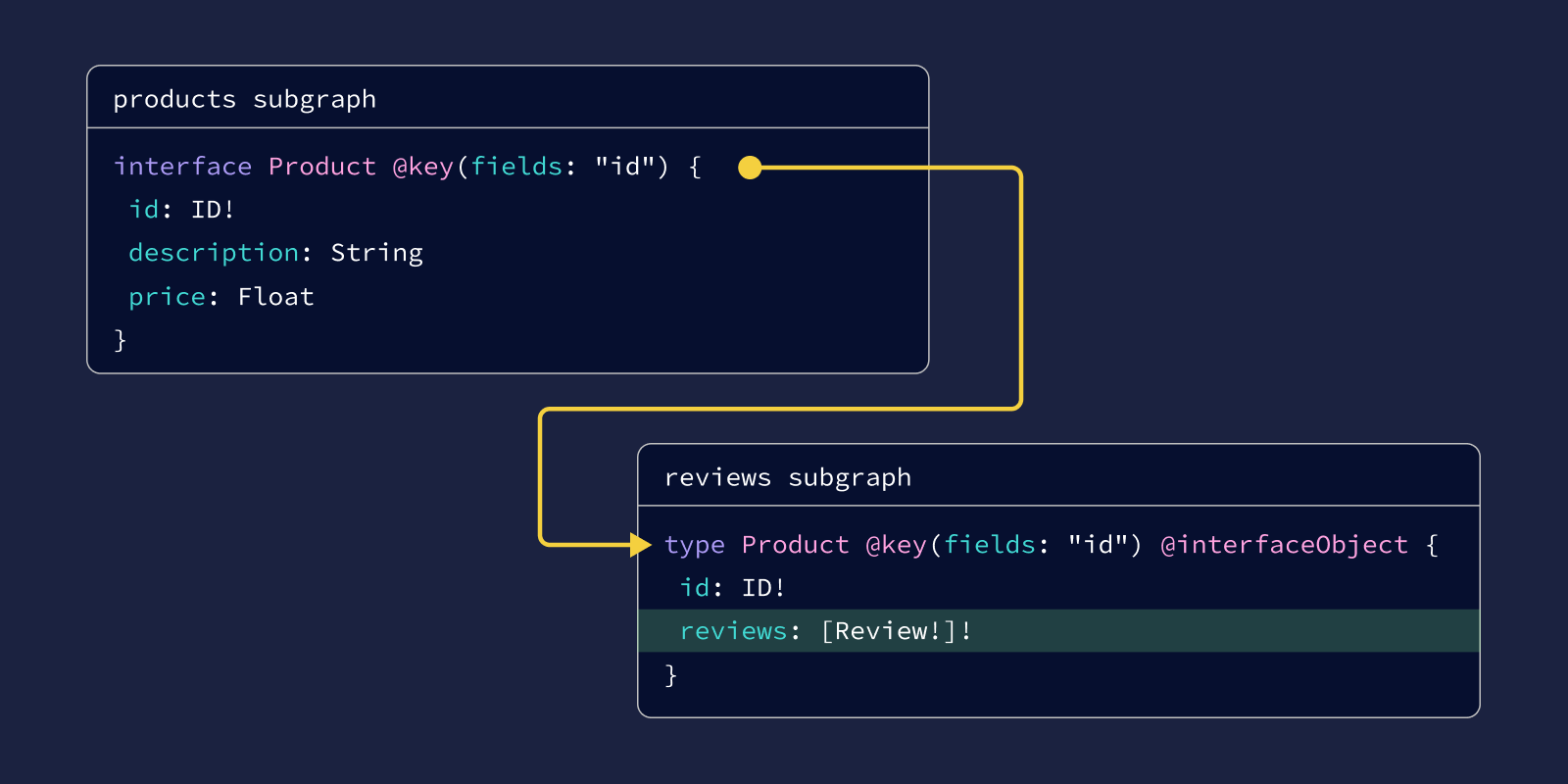
Apollo Federation is widely adopted as the standard specification for building distributed GraphQL APIs, called supergraphs, that run on top of one or more underlying subgraphs. Unlike a monolithic graph, a supergraph maintains clear separation of concerns — each subgraph can be owned independently by separate developers or teams — allowing it to evolve rapidly as new use cases arrive.
Now generally available and fully supported by Apollo GraphOS, the Apollo Federation 2.3 spec further improves separation of concerns in a supergraph by adding support for entity interfaces and the new @interfaceObject directive. Entity interfaces (interfaces with a @key) defined in one subgraph can now be abstracted as an object type in other subgraphs using @interfaceObject. Those subgraphs can then add and resolve fields directly on that interface in the supergraph.
To get started with entity interfaces and @interfaceObject, please see the Apollo Federation documentation or read on. In the post below, we’ll discuss the challenges of reusing interfaces across multiple subgraphs, and walk through an example of using @key on interface definitions and @interfaceObject to solve these challenges.
The challenges of reusing interfaces across subgraphs
In GraphQL, interfaces specify a set of fields that all implementing object types must include. They are particularly helpful for the abstraction they provide — they allow you to return a set of objects of different types, without needing to know what those concrete types are. For example, if object types Book and Movie implement the Product interface, you can have the following query:
type Query {
products: [Product!]!
}This query will return all objects that implement the Product interface, making the graph more flexible over time. If new objects are added that implement the Product interface, we don’t need to change our query — all new objects will be returned.
Since interfaces were originally designed for a monolithic graph architecture, there were a few challenges in reusing interfaces across federated subgraphs prior to this release. Specifically, if an interface and all of its concrete implementations were defined in subgraphA, subgraphB couldn’t easily add fields to the interface or resolve those fields without duplicating all of its concrete implementations. This can often negate the abstraction benefits of interfaces, since both subgraphs need to know everything about the interface.
Let’s consider an example:
Example: adding a field to an interface in another subgraph without @interfaceObject
Let’s say we have a products subgraph that defines a Product interface. We then have two entity object types (Book and Movie) that implement that interface:
# products subgraph
type Query {
products: [Product!]!
}
interface Product {
id: ID!
description: String
price: Float
}
# Book entity with key
type Book implements Product @key(fields: "id") {
id: ID!
description: String
price: Float
pages: Int
}
# Movie entity with key
type Movie implements Product @key(fields: "id") {
id: ID!
description: String
price: Float
duration: Int
}We also have another subgraph, reviews, which enables users to leave reviews on any product. In this example, we want to get all the best-reviewed products of any product type – this is achieved through the query bestRatedProducts that returns all objects implementing the Product interface.
Without @interfaceObject, our reviews subgraph would need to look like this:
# reviews subgraph
type Query {
bestRatedProducts(limit: Int): [Product!]!
}
interface Product {
id: ID!
reviews: [Review!]!
}
type Review {
author: String
text: String
rating: Int
}
# Book entity with key
type Book implements Product @key(fields: "id") {
id: ID!
reviews: [Review!]!
}
# Movie entity with key
type Movie implements Product @key(fields: "id") {
id: ID!
reviews: [Review!]!
}There are a few problems with the workflow presented above:
- Lots of repetition — the
reviewssubgraph needs to duplicate all the entity types that implement theProductinterface (BookandMovie). - Leaky abstraction — we can’t truly abstract the
Productsinterface across multiple subgraphs. If a subgraph defines an interface, it also needs to define all of its concrete implementations – when ideally, we shouldn’t have to know what concrete objects are implementingProduct. However, we can’t remove theBookorMoviedefinitions in ourreviewssubgraph without making our subgraph an invalid GraphQL service. - Extensive coordination — any time we want to add a new type that implements the
Productinterface, we need to add it to both theproductssubgraph and thereviewssubgraph. If these subgraphs are owned by different teams, we need to make sure those teams are in lockstep coordination to make the change. This issue is compounded for any other subgraphs that need to contribute to the interface.
Distributing interface definitions with entity interfaces and @interfaceObject
Ideally, our goal is to allow the reviews subgraph to do the following without duplicating each type that implements the Product interface:
- Add a
reviewsfield to theProductinterface defined in theproductssubgraph - Add the
reviewsfield to each type that implements theProductinterface (including any future implementation types) - Resolve the
reviewsfield directly on theProductinterface for all implementation types
In order to accomplish this, Federation 2.3 introduces two things:
- Support for creating entity interfaces by adding the
@keydirective to interface definitions. - A new directive,
@interfaceObject, which allows you to abstract an entity interface in isolation by declaring it locally as an object type. This enables you to contribute fields to the interface without needing to redefine all of the interface’s concrete implementation types.
Let’s apply these to our example.
Create an entity interface with @key
Before we can use @interfaceObject in our reviews subgraph, we need to add a @key to our Product interface definition in the products subgraph. This enables the products subgraph to resolve the implementation type of the abstracted Product objects returned by the reviews subgraph.
If we try to use @interfaceObject to abstract an interface that doesn’t have a @key, we’ll get an error during composition.
Here’s what our products subgraph schema looks like with Product defined as an entity interface:
# products subgraph
type Query {
products: [Product!]!
}
# Entity interface definition with key
interface Product @key(fields: "id") {
id: ID!
description: String
price: Float
}
# Book entity with key
type Book implements Product @key(fields: "id") {
id: ID!
description: String
price: Float
pages: Int
}
# Movie entity with key
type Movie implements Product @key(fields: "id") {
id: ID!
description: String
price: Float
duration: Int
}Abstract an entity interface locally with @interfaceObject
Now that we’ve made Product an entity interface, we can use the new @interfaceObject to declare Product locally as an object type in our reviews subgraph. Put simply, @interfaceObject essentially lets us “convert” an entity interface to an object type in our subgraph only, so that we can avoid duplicating all of its concrete implementations while still keeping our schema valid.
To illustrate, here’s what our reviews subgraph looks like when using @interfaceObject to abstract the Product entity interface and add a reviews field to it:
# reviews subgraph
# Get the best-reviewed products regardless of type
type Query {
bestRatedProducts(limit: Int): [Product!]!
}
# Entity interface is declared as an object type locally
type Product @key(fields: "id") @interfaceObject {
id: ID!
# reviews field is automatically added to all objects that
# implement the Product interface
reviews: [Review!]!
}
type Review {
author: String
text: String
rating: Int
}In the reviews subgraph, our Product entity interface is now an object type, and we’ve added the reviews field to the interface. However, since we’ve decorated Product with @interfaceObject, we’re telling composition (and any human readers) that “this object type is actually an interface type in the supergraph schema, but I’m abstracting it locally.”
During composition, the reviews field is automatically added to the interface definition and to the definition of each entity type that implements the Product entity interface — Book, Movie, and any others added in the future. This allows us to treat the Product interface as an opaque abstraction so that we can evolve the graph over time without intensive cross-team coordination.
Query the entity interface
Now that we’ve defined our Product entity interface and added the reviews field to it with @interfaceObject, let’s consider how our supergraph would handle the following query:
query {
bestRatedProducts(limit: 10) {
__typename
price
}
}With @interfaceObject, we can now query the reviews subgraph to get the ten best-rated products and their id. However, we also need to know if each id is a Book or Movie type. Our reviews subgraph doesn’t know the details of each implementation type, but since we have @key defined on the Product interface, the products subgraph is able to resolve the __typename for each id returned by the reviews subgraph.
Getting started with entity interfaces
If you are new to Apollo Federation…
Read the Apollo Federation documentation to get started. Or, if you want a more structured tutorial for Federation, check out our hands-on Odyssey Course on Federation.
If you’re experienced with Federation and have a supergraph…
Great news! Apollo GraphOS fully supports the Federation 2.3 spec including @interfaceObject and @key on interfaces. This includes:
- GraphOS cloud routing and self-hosted Apollo Router/Gateway support
- Composition in GraphOS Studio
To learn more about requirements and rules for using entity interfaces in Federation, please see this section in our documentation.
*Note: If you’re using a self-hosted router or gateway, you’ll also need to ensure you are using a version that supports the Federation 2.3 spec (Apollo Router v1.10.2+ or Apollo Gateway v2.3+ ).
Thank you!
Finally, we want to say a huge thank you to the Apollo Federation and GraphOS community for the continuous feedback which has been instrumental in the design of these new features. If you have any questions on Federation, @interfaceObject, or @key on interfaces, don’t hesitate to reach out on our community forum or our Discord server.
Resources

Written by
Korinne Alpers
Stay in our orbit!
Become an Apollo insider and get first access to new features, best practices, and community events. Oh, and no junk mail. Ever.
Make this article better!
Was this post helpful? Have suggestions? Consider so we can improve it for future readers ✨.